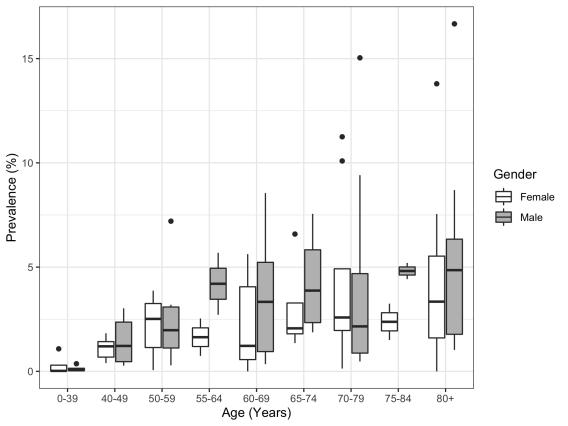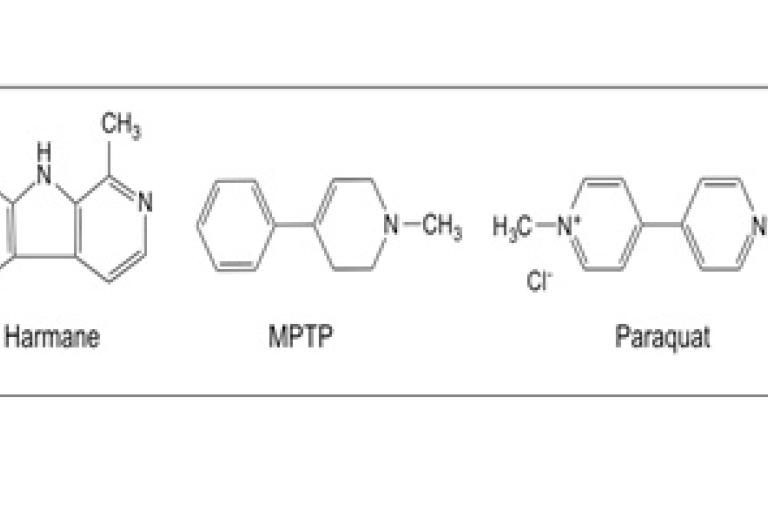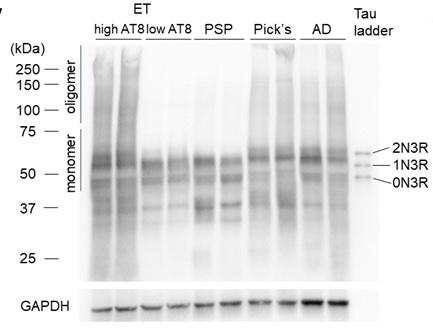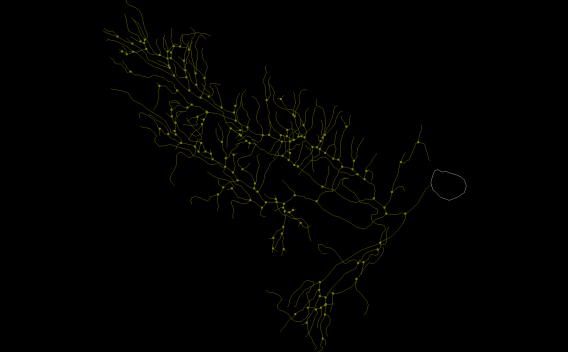A central goal of our studies is to unravel the causes and mechanisms underlying tremor disorders. We aim to understand a fundamental set of questions – what factors set these diseases in motion (primary causes or etiological factors), and what are the tissue-based and physiological changes that occur once these diseases are set in motion?
Secondly, we aim to advance our knowledge about the clinical features, factors that influence clinical progression, and associated co-morbidities of these disorders. Many of our studies focus on essential tremor (ET), which is a highly prevalent disease, affecting 2.2% of the entire U.S. population. We employ a wide variety of approaches to address these questions.
Despite being considered such a common disease, a basic understanding about the population prevalence of ET was unknown for many years. When Dr. Louis began studying ET approximately 30 years ago, aside from a few scattered studies, there was virtually no associated epidemiology. Dr. Louis’ team started conducted fundamental epidemiological studies in the northern Manhattan in the 1990s, and over the past 3 decades he has extended those studies to other populations in Turkey, Spain, Bangladesh, the Faroe Islands, and elsewhere, laying down the descriptive epidemiology of ET - prevalence, incidence, and clinical features - in diverse population samples. A prevalence study of ET in Turkey was designed with using a door-to-door approach, and it provides one of the most valid estimates of disease prevalence in the neurological literature. Aside from these studies defining the descriptive epidemiology of ET, our epidemiological studies have demonstrated that ET itself significantly increases the risk for developing other degenerative disorders such as Alzheimer’s disease and Parkinson’s disease, and that ET itself seems to increase risk of mortality.

Louis ED, Marder K, Cote L, Pullman S, Ford B, Wilder D, Tang M-X, Lantigua R, Gurland B, Mayeux R. Differences in the prevalence of essential tremor among elderly African-Americans, Whites and Hispanics in Northern Manhattan, NY. Arch Neurol 1995;52:1201-1205.
Louis ED, Marder K, Cote L, Wilder D, Tang M-X, Lantigua R, Gurland B, Mayeux R. Prevalence of a history of shaking in persons 65 years and older: Diagnostic and functional consequences. Movement Disorders 1996;11:63-69.
Louis ED, Ford B, Wendt KJ, Cameron G. Clinical characteristics of essential tremor: Data from a population-based cohort. Movement Disorders 1998;13:803-808.
Dogu O, Sevim S, Camdeviren H, Sasmaz T, Bugdayci R, Aral M, Kaleagasi H, Un S, Louis ED. Prevalence of essential tremor: Door-to-door neurological exams in Mersin Province, Turkey. Neurology 2003;61:1804-1807.
Cohen O, Pullman S, Jurewicz E, Watner D, Louis ED. Rest tremor in essential tremor patients: Prevalence, clinical correlates, and electrophysiological characteristics. Arch Neurol 2003;60:405-410.
Benito-Leon J, Bermejo-Pareja F, Louis ED. Incidence of essential tremor in three elderly populations of central Spain. Neurology 2005;64:1721-1725.
Louis ED, Benito-Leon J, Ottman R, Bermejo-Pareja F. A population-based study of mortality in essential tremor. Neurology 2007;69:1982-1989.
Bermejo-Pareja F, Louis ED, Benito-Leon J. Risk of incident dementia in essential tremor: A population-based study. Movement Disorders 2007;22:1573-1580.
Benito-Leon J, Louis ED, Bermejo-Pareja F. Risk of incident Parkinson’s disease and parkinsonism in essential tremor: A population-based study. Journal of Neurology, Neurosurgery & Psychiatry 2009;80:423-425.
Louis ED, Hafeman D. Parvez F, Alcalay RN, Islam T, Baker Siddique A, Islam Patwary T, Melkonian S, Argos M, Levy D, Ahsan H. Prevalence of essential tremor Arihazar, Bangladesh: A population-based study. Neuroepidemiology 2011;36:71-76.
Michalec M, Gillman A, Louis ED. Incidence rates of cranial tremors in essential tremor: A prospective, longitudinal study. Neuroepidemiology 2014;43:150-154.
Louis ED, Ottman R. How many people in the United States have essential tremor? Deriving a population estimate based on epidemiological data. Tremor Other Hyperkinetic Movements 2014; 14; 4:259 doi: 10.7916/D8TT4P4B.
Louis ED, Factor-Litvak P. Screening for and estimating the prevalence of essential tremor: a random-digit dialing-based study in the New York Metropolitan area. Neuroepidemiology 2016;46:51-56.
Eliasen EH, Ferrer M, Gaini S, Louis ED, Petersen MS. Prevalence of essential tremor in the Faroe Islands: A population-based study. Neuroepidemiology 2019;52:227-236.
Louis ED, McCreary M. How common is essential tremor? Update on the worldwide prevalence of essential tremor. Tremor Other Hyperkinetic Movements 2021; July 9;11:28.
Louis ED, Iglesias-Hernandez D, Hernandez NC, Flowers X, Kuo SH, Vonsattel SPG, Faust PL. Characterizing Lewy pathology in 231 essential tremor brains from the essential tremor centralized brain repository. Journal of Neuropathology & Experimental Neurology 2022;81:796-806.
Why do people develop ET to begin with? What predisposes them? What sets the disease in motion? In 2000, data was emerging from our lab suggested that, contrary to accepted dogma, genetic factors could not explain all of the cases of disease in the population. Hence, a search for environmental causes was launched. Risk Factors for Essential Tremor is a longitudinal NIH-funded study, the goal of which is to explore and uncover environmental toxicants that are linked with tremor. Through these studies, which have spanned more than 20 years and have been conducted in populations in the U.S. and Europe, we identified several putative environmental exposures that are associated with ET, including the beta-carboline alkaloids (harmane) and possibly lead, suggesting that these ubiquitous toxins may play a role in the etiology of ET. As such, these may be the first and only identified modifiable risk factors for ET. Advancing this research from the observational to the interventional realm, a clinical trial is currently in the planning phase, to try to modify the disease progression based on reduction in exposure to one of these toxins.

Louis ED. Etiology of essential tremor: Should we be searching for environmental causes? Movement Disorders 2001;16:822-829.
Louis ED, Zheng W, Jurewicz EC, Watner D, Chen J, Factor-Litvak P, Parides M. Elevation of blood β- carboline alkaloids in essential tremor. Neurology 2002;59:1940-1944.
Louis ED, Jurewicz EC, Applegate L, Factor-Litvak P, Parides M, Andrews L, Slavkovich V, Graziano JH, Carroll S, Todd A. Association between essential tremor and blood lead concentration. Environmental Health Perspectives 2003;111:1707-1711.
Dogu O, Louis ED, Tamer L, Unal O, Yilmaz A, Kaleagasi H. Elevated blood lead concentrations in essential tremor: A case-control study in Mersin, Turkey. Environmental Health Perspectives 2007;115:1564-1568.
Louis ED, Factor-Litvak P, Gerbin M, Slavkovich V, Graziano JH, Jiang W, Zheng W. Blood harmane, blood lead, and severity of hand tremor: Evidence of additive effects. NeuroToxicology 2011;32:227-232.
Louis ED, Benito-León J, Moreno-Garcia S, Vega S, Romero JP, Bermejo-Pareja F, Gerbin M, Viner AS, Factor-Litvak P, Jiang W, Zheng W. Blood harmane (1-Methyl-9h-Pyrido[3,4-B]Indole) concentration in essential tremor cases in Spain. NeuroToxicology 2013;34:264-268.
Louis ED, Factor-Litvak P, Liu X, Vonsattel JPG, Galecki M, Jiang W, Zheng W. Elevated brain harmane (1-methyl-9H-pyrido[3,4-b]indole) in essential tremor cases vs. controls. NeuroToxicology 2013;38:131-135.
Ji JS, Power MC, Sparrow D, Spiro A, Hu H, Louis ED, Weisskopf MG. Lead exposure and tremor in the VA Normative Aging Study. Environmental Health Perspectives 2015;123:445-450.
Louis ED, Eliasen EH, Ferrer M, Iglesias Hernandez D, Gaini S, Jiang W, Zheng W, Nielsen F, Skaalum Petersen M. Blood harmane (1-methyl-9H-pyrido[3,4-b]índole) and mercury in essential tremor: A population-based, environmental epidemiology study in the Faroe Islands. Neuroepidemiology 2020;54:272-280.
When Dr. Louis began studying ET approximately 30 years ago, there were surprisingly few ET- specific rating scales. This made it difficult to study the disease in a standardized manner. Since then, our lab has dedicated a great deal of effort to the development and validation of standardized assessment tools for ET. These include screening questionnaires, clinical rating scales, and functional assessments. These published assessment tools are now widely used in ET research.

Louis ED, Ford B, Lee H, Andrews H. Does a screening questionnaire for essential tremor agree with the physician's examination? Neurology 1998;50:1351-1357.
Louis ED, Wendt KJ, Albert SM, Pullman SL, Yu Q, Andrews H. Validity of a performance-based test of function in essential tremor. Arch Neurol 1999;56:841-846.
Louis ED, Barnes LF, Wendt KJ, Albert SM, Pullman SL, Yu Q, Schneier FR. Validity and test-retest reliability of a disability questionnaire for essential tremor. Movement Disorders 2000;15:516-523.
Traub R, Gerbin M, Mullaney MM, Louis ED. Development of a tremor embarrassment assessment. Parkinsonism & Related Disorders 2010;16:661- 665.
Louis ED, Zhao Q, Meng H, Ding D. Screening for action tremor in epidemiological field surveys: assessing the reliability of a semi-quantitative, visual, template-based scale for rating hand-drawn spirals. Tremors & Other Hyperkinetic Movements 2012;2:1-6 (pii 46).
Trujillo-Diaz D, Cersonsky TEK, Kellner S, Zdrodowska MA, Hickman R, Cosentino S, Monin JK, Louis ED. Enfeeblement in essential tremor: Development and validation of a new psychometric measure. Journal of Geriatric Psychiatry and Neurology 2019;32:145-151.
O’Suilleabhain P, Tovar M, Wagle Shukla A, Tester NJ, Lundervold DA, Turner TH, Howe-Martin L, Louis ED. Development of ETStig, a measure for stigma in essential tremor. Parkinsonism & Related Disorders 2022;104:38-43.
ET has canonically been viewed as a motor disorder, yet there has been an emerging recognition of non-motor, and particularly, cognitive features. From studies in our lab over the past 15 – 20 years, we have observed that these cognitive features range from mild to severe, and they are associated with increased odds and increased risks of dementia in epidemiological studies. We have further identified what we believe to be a pre-motor stage to the disease, in which cognitive and other non-motor features seem to precede the tremor. Along with key collaborators, and through a large, NIH-funded prospective, longitudinal cohort we have established (Clinical Pathological Study of Cognitive Impairment in ET), we are characterizing the clinical features and postmortem correlates of the cognitive features of ET. Through these studies, we are exploring what seems to be a link between ET and tau protein biology abnormalities.

Benito-Leon J, Louis ED, Bermejo-Pareja F. Population-based case-control study of cognitive function in essential tremor. Neurology 2006;66:69-74.
Benito-Leon J, Louis ED, Bermejo-Pareja F. Elderly onset essential tremor is associated with dementia. The NEDICES study. Neurology 2006;66:1500-1505.
Bermejo-Pareja F, Louis ED, Benito-Leon J. Risk of incident dementia in essential tremor: A population- based study. Movement Disorders 2007;22:1573-1580.
Thawani SP, Schupf N, Louis ED. Essential tremor is associated with dementia: Prospective population-based study in New York. Neurology 2009;73:621-625.
Benito-León J, Louis ED, Sánchez-Ferro Á, Bermejo-Pareja F. Rate of cognitive decline in the premotor phase of essential tremor: A prospective study (NEDICES). Neurology 2013;81:60-66.
Pan JJ, Lee M, Honig LS, Vonsattel JP, Faust PL, Louis ED. Alzheimer’s-related changes in non-demented essential tremor patients vs controls: Links between tau and tremor? Parkinsonism & Related Disorders 2014;20:655-658.
Louis ED, Rohl B, Collins K, Cosentino S. Poorer cognitive performance in patients with essential tremor-Parkinson’s disease vs. patients with Parkinson’s disease. Frontiers in Neurology 2015;6:106.
Louis ED, Collins K, Kellner S, Morgan S, Rohl B, Huey E, Cosentino S. Cognitive dysfunction is associated with greater imbalance and falls in patients with essential tremor. Frontiers in Neurology 2017;8:154.
Collins K, Rohl B, Morgan S, Huey E, Cosentino S, Louis ED. Mild cognitive impairment subtypes in a cohort of elderly essential tremor cases. Journal of the International Neuropsychology Society 2017;23:390-399.
Cersonsky T, Morgan S, Kellner S, Robakis D, Liu X, Huey E, Louis ED, Cosentino S. Diagnosing mild cognitive impairment in essential tremor: How many and which neuropsychological tests? Journal of the International Neuropsychology Society 2018;24(10):1084-1098.
Farrell K, Cosentino S, Ida M, Chapman S, Bennett DA, Louis ED, Crary JF. Quantitative assessments of pathological tau burden in essential tremor: A postmortem study. Journal of Neuropathology & Experimental Neurology 2019;78:31-37.
Meyers J, Hickman R, Cristal AD, Factor-Litvak P, Cosentino S, Louis ED. More unaffected first-degree relatives of essential tremor cases have mild cognitive impairment than age-matched controls. Parkinsonism & Related Disorders 2019;61:144-150.
Radler KH, Zdrodowska BS, Dowd H, Cersonsky TEK, Huey ED, Cosentino S, Louis ED. Rate of progression from mild cognitive impairment to dementia in an essential tremor cohort: A prospective, longitudinal study. Parkinsonism & Related Disorders 2020;74:38-42.
Cersonsky TEK, Kellner S, Chapman S, Huey ED, Louis ED, Cosentino S. Profiles of normal cognition in essential tremor. Journal of the International Neuropsychology Society 2020;26:197-209.
Kim SH, Farrell K, Cosentino S, Vonsattel J-P, Faust PL, Cortes E, Bennett DA, Louis ED, Crary JF. Tau isoform profile in essential tremor diverges from other taupathies. Journal of Neuropathology & Experimental Neurology 2021;80:835-843.
Delgado N, Iglesias Hernandez D, Radler K, Huey ED, Cosentino S, Louis E. Mild cognitive impairment, dementia and risk of mortality in essential tremor: A longitudinal prospective study of elders. Journal of the Neurological Sciences 2021;600:472-477.
Miller JR, Chapman S, Iglesias Hernandez D, Radler K, Huey ED, Louis ED, Cosentino S. Depressive symptoms predict memory decline in essential tremor. Parkinsonism & Related Disorders 2022;98:16-20.
McGurn M, Dworkin JD, Chapman S, Huey ED, Cosentino S, Louis ED. Can the Montreal Cognitive Assessment and Mini-Mental State Examination detect cognitive decline in elderly patients with essential tremor? The Clinical Neuropsychologist 2022;June 28:1-18.
What is the pathophysiology of ET? The existing dogma was that there was “no identifiable pathology” in ET and the disease was the result of an electrical disarrangement. However, as recently as 2003, there had only been 15 published postmortem brain examinations, many of which were performed 50 – 100 years ago and none using modern, controlled methods. Hence, our understanding of the pathophysiology of ET was largely unexplored. In June of 2003, in collaboration with Dr. Jean Paul Vonsattel (Neuropathology), Dr. Louis established the Essential Tremor Centralized Brain Repository, which is a centralized repository for the collection and study of ET brains in the United States. He was joined by Dr. Phyllis Faust (Neuropathology) in 2005. This is a nationwide network of more than 200 ET patients who have signed up as brain donors and whom we follow regularly. The repository now has the largest collection of ET brains in the world (more than 250). Teaming up with Dr. Faust at Columbia University, the two run a laboratory-based program that has carefully characterized and catalogued postmortem changes in ET, with findings now spanning 60 papers. From these bedside-to-bench studies, we see that the largest concentration of postmortem changes in ET is in the cerebellar cortex and that the pathological changes are degenerative. This work has given rise to a new model of disease pathophysiology - the cerebellar degenerative model of ET. Studies are active and continuing.

Louis ED, Faust PL, Vonsattel JPG, Honig LS, Rajput A, Robinson CA, Rajput A, Pahwa R, Lyons KE, Ross W, Borden S, Moskowitz CB, Lawton A, Hernandez N. Neuropathological changes in essential tremor: 33 cases compared with 21 controls. Brain 2007;130:3297-3307.
Axelrad JE, Louis ED, Honig LS, Flores I, Ross GW, Pahwa R, Lyons KE, Faust PL, Vonsattel JP. Reduced Purkinje cell number in essential tremor: A Postmortem study. Arch Neurol 2008;65:101-107.
Louis ED, Yi H, Erickson-Davis C, Vonsattel JPG, Faust PL. Structural study of Purkinje cell axonal torpedoes in essential tremor. Neuroscience Letter 2009;450:287-291.
Louis ED, Faust PL, Vonsattel JPG, Honig LS, Rajput A, Rajput A, Pahwa R, Lyons KE, Ross GW, Elble RJ, Erickson-Davis C, Moskowitz CB, Lawton A. Torpedoes in Parkinson’s disease, Alzheimer’s disease, essential tremor, and control brains. Movement Disorders 2009;24:1600-1605.
Erickson-Davis CR, Faust PL, Vonsattel JGV, Gupta S, Honig LS, Louis ED. “Hairy baskets” associated with degenerative Purkinje cell changes in essential tremor. Journal of Neuropathology & Experimental Neurology 2010;69:262-271.
Kuo S-H, Erickson-Davis C, Gillman A, Faust PL, Vonsattel JPG, Louis ED. Increased number of heterotopic Purkinje cells in essential tremor. Journal of Neurology, Neurosurgery & Psychiatry 2011;82:1038-40.
Yu M, Ma K, Faust PL, Honig LS, Cortés E, Vonsattel JPG, Louis ED. Increased number of Purkinje cell dendritic swellings in essential tremor. European Journal of Neurology 2012;19:625-630.
Louis ED, Faust PL, Ma K, Babij R, Cortés E, Liem RK, Vonsattel JPG. Neurofilament protein levels: Quantitative analysis in essential tremor cerebellar cortex. Neuroscience Letter 2012;518:49-54.
Louis ED, Babij R, Cortés E, Vonsattel JPG, Faust PL. The inferior olivary nucleus: A postmortem examination of essential tremor cases vs. controls. Movement Disorders 2013;28:779-786.
Kuo SH, Tang G, Louis ED, Ma K, Babij R, Balatbat M, Cortes E, Vonsattel JPG, Yamamoto A, Sulzer D, Faust PL. Lingo-1 expression is increased in essential tremor cerebellum and is present in Basket cell pinceau. Acta Neuropathologica 2013;125:879-889.
Babij R, Lee M, Cortés E, Vonsattel JPG, Faust PL, Louis ED. Purkinje cell axonal anatomy: Quantifying morphometric changes in essential tremor vs. control brains. Brain 2013;136:3051-3061.
Lin C-Y, Louis ED, Faust PL, Koeppen AH, Vonsattel JPG, Kuo S-H. Abnormal climbing fiber-Purkinje cell synaptic connections in the essential tremor cerebellum. Brain 2014;137:3149-3159.
Louis ED, Lee M, Babij R, Ma K, Cortes E, Vonsattel JPG, Faust PL. Reduced Purkinje cell dendritic arborization and loss of dendritic spines in essential tremor. Brain 2014;137:3142-8.
Lee M, Chang MM, Lin C-Y, Louis ED, Faust PL, Kuo SH. Decreased EAAT2 protein expression in the essential tremor cerebellar cortex. Acta Neuropathologica 2014;2:157.
Choe M, Cortés E, Vonsattel JPG, Kuo SH, Faust PL, Louis ED. Purkinje cell loss in essential tremor: Random sampling quantification and nearest neighbor analysis. Movement Disorders 2016;31;393-401.
Kuo SH, Lin CY, Wang J, Sims PA, Pan M-K, Liou J-y, Lee D, Tate WJ, Kelly GC, Louis ED, Faust PL. Climbing fiber-Purkinje cell synaptic pathology in tremor and cerebellar degenerative diseases. Acta Neuropathologica 2017;133:121-138.
Louis ED, Kuo SH, Tate WJ, Kelly GC, Gutierrez J, Cortes EP, Vonsattel JPG, Faust PL. Heterotopic Purkinje cells: A comparative postmortem study of essential tremor and spinocerebellar ataxias 1, 2, 3, and 6. Cerebellum 2018;17:104-110.
Lee JS, Kerridge CO, Chatterjee D, Koeppen AH, Faust PL, Louis ED. A quantitative study of empty baskets in essential tremor and other motor neurodegenerative diseases. Journal of Neuropathology & Experimental Neurology 2019;78:113-122.
Louis ED, Kerridge CA, Chatterjee D, Martuscello RT, Trujillo Diaz D, Koeppen AH, Kuo S-H, Vonsattel JPG, Sims PA. Faust PL. Contextualizing the pathology in the essential tremor cerebellum: A patholog- omics approach. Acta Neuropathologica 2019;138:859-876.
Louis ED, Iglesias-Hernandez D, Hernandez NC, Flowers X, Kuo SH, Vonsattel SPG, Faust PL. Characterizing Lewy pathology in 231 essential tremor brains from the essential tremor centralized brain repository. Journal of Neuropathology & Experimental Neurology 2022;81:796-806.
Martuscello R, Sivprakasam K, Hartstone W, Kuo SH, Konopka G, Louis ED, Faust PL. Gene expression analysis of laser captured Purkinje cells in the essential tremor cerebellum. Cerebellum 2022 Oct 15.
Louis ED, Martuscello RT, Gionco JT, Hartstone WG, Musacchio JB, Portenti M, McCreary M, Kuo S-H, Vonsattel JPG, Faust PL.. Histopathology of the cerebellar cortex in essential tremor and other neurodegenerative motor disorders: Comparative analysis of 320 brains. Acta Neuropathologica (2023, In Press).